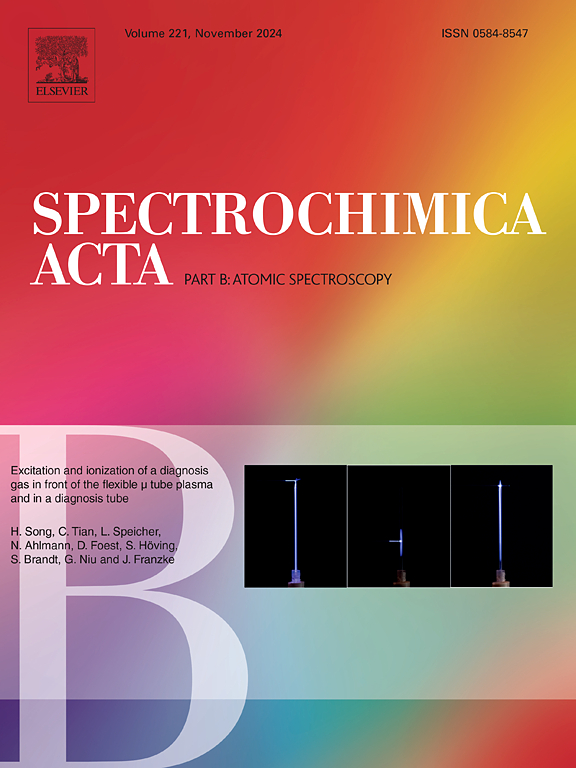使用串联p-LIBS -颗粒回收模块的新型现场微采样技术的开发:应用于碳酸钙样品的230Th/238U定年
IF 3.8
2区 化学
Q1 SPECTROSCOPY
引用次数: 0
摘要
研究史前洞穴墙壁最具挑战性的一个方面是采样步骤,尽管采取了广泛的预防措施,但往往达不到管理员的要求。理想情况下,只有在微创条件下才能避免或接受取样。这一挑战对于确定史前岩石绘画的年代尤其重要,因为实验室分析需要对绘画进行直接采样。铀钍地球计时器提供了一个有趣的选择,因为它可以在不直接瞄准画作的情况下估计画作的年龄。相反,它专注于沉淀的碳酸盐,被称为洞穴,它们在周围丰富,甚至可能覆盖在岩石上。然而,采样步骤仍然是一个挑战,主要是因为需要精确的采样,并且因为这些分析通常需要在最佳条件下至少mg大小的样品。在这项研究中,我们改进了便携式激光诱导击穿光谱仪(LIBS),加入了一个诱导粒子收集模块。此外,我们开发了一种烧蚀策略,从碳酸钙样品中去除约1mg的物质,包括石灰石板、洞穴和珊瑚,产生最大尺寸约为900 x 900 x 700 μm(长x宽x深)的方形金字塔形烧蚀陨石坑。对收集模块的效率进行了评估,结果显示其回收率接近烧蚀总质量的80%。该采样方案还应用于MC-ICP-MS分析后确定U/Th年龄的两个已知样品。计算出的U/Th年龄与预期值吻合较好,表明所提出的采样方法可以为碳酸盐洞穴和遮蔽物的微侵入调查提供一种新的方法。本文章由计算机程序翻译,如有差异,请以英文原文为准。

Development of a novel field micro-sampling technique using a tandem p-LIBS – particle recovery module: Application to calcium carbonate samples for 230Th/238U dating
One of the most challenging aspects of studying prehistoric cave walls is the sampling step which, despite extensive precautions, often falls short of meeting curators’ requirements. Sampling is ideally avoided or accepted only under micro-invasive conditions. This challenge is particularly significant in dating prehistoric rock painting, as laboratory analyses require direct sampling of the painting. The uranium-thorium geo-chronometer offers an interesting alternative, as it allows to estimate the age of a painting without targeting it directly. Instead, it focuses on the precipitated carbonate, known as speleothems, which are abundant in their surroundings and may even overlay rock painting. The sampling step remains nevertheless a challenge, primarily because precise sampling is required, and because these analyses typically require at least mg-sized samples in optimal conditions. In this study, we modified a portable Laser Induced Breakdown Spectrometer (LIBS) to incorporate an induced particle collection module. Additionally, we developed an ablation strategy to remove approximately 1mg of material from calcium carbonate samples, including limestone slab, speleothems, and corals, producing square-based pyramidal ablation craters with maximal dimensions of about 900 x 900 x 700 μm (length x width x depth). Evaluation of the efficiency of the collection modules revealed a high recovery rate of nearly 80% of the total ablated mass. This sampling protocol was additionally applied to two known samples for which U/Th ages were determined after MC-ICP-MS analyses. Calculated U/Th ages were in good agreement with their expected values, suggesting that the proposed sampling methodology could offer a novel mean for micro-invasive investigations in carbonate caves and shelters.
求助全文
通过发布文献求助,成功后即可免费获取论文全文。
去求助
来源期刊
CiteScore
6.10
自引率
12.10%
发文量
173
审稿时长
81 days
期刊介绍:
Spectrochimica Acta Part B: Atomic Spectroscopy, is intended for the rapid publication of both original work and reviews in the following fields:
Atomic Emission (AES), Atomic Absorption (AAS) and Atomic Fluorescence (AFS) spectroscopy;
Mass Spectrometry (MS) for inorganic analysis covering Spark Source (SS-MS), Inductively Coupled Plasma (ICP-MS), Glow Discharge (GD-MS), and Secondary Ion Mass Spectrometry (SIMS).
Laser induced atomic spectroscopy for inorganic analysis, including non-linear optical laser spectroscopy, covering Laser Enhanced Ionization (LEI), Laser Induced Fluorescence (LIF), Resonance Ionization Spectroscopy (RIS) and Resonance Ionization Mass Spectrometry (RIMS); Laser Induced Breakdown Spectroscopy (LIBS); Cavity Ringdown Spectroscopy (CRDS), Laser Ablation Inductively Coupled Plasma Atomic Emission Spectroscopy (LA-ICP-AES) and Laser Ablation Inductively Coupled Plasma Mass Spectrometry (LA-ICP-MS).
X-ray spectrometry, X-ray Optics and Microanalysis, including X-ray fluorescence spectrometry (XRF) and related techniques, in particular Total-reflection X-ray Fluorescence Spectrometry (TXRF), and Synchrotron Radiation-excited Total reflection XRF (SR-TXRF).
Manuscripts dealing with (i) fundamentals, (ii) methodology development, (iii)instrumentation, and (iv) applications, can be submitted for publication.

 求助内容:
求助内容: 应助结果提醒方式:
应助结果提醒方式:


